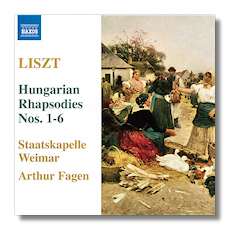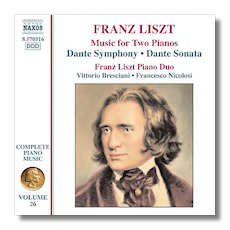
The Internet's Premier Classical Music Source
Related Links
- Liszt Reviews
- Latest Reviews
- More Reviews
-
By Composer
-
Collections
DVD & Blu-ray
Books
Concert Reviews
Articles/Interviews
Software
Audio
Search Amazon
Recommended Links
Site News
 CD Review
CD Review
Franz Liszt

Hungarian Rhapsodies, S. 359
Orchestral Version, by Liszt and Franz Doppler
Staatskapelle Weimar/Arthur Fagen
Naxos 8.570230


Music for Two Pianos
- Dante Symphony (arr. Liszt, with chorus)
- Années de pèlerinage, deuxième année, S. 161 "Italie": #77, Après une lecture du Dante (arr. Vittorio Bresciani)
Barbara Szmodics, treble
Vittorio Bresciani & Francesco Nicolosi, pianos
Hungarian Radio Children's Choir/Gabriella Thesz
Naxos 8.570516
The orchestral version of the Hungarian Rhapsodies was fashioned by composer/flutist Franz Doppler and Liszt, though Liszt insisted that Doppler be given full credit for it. Liszt revised that version in any event and almost certainly had a significant hand in the original. The orchestral version, consisting of six rhapsodies, reorders the originals thusly: 14, 12, 6, 2, 5 and 9. But Arthur Fagen changes that sequence to this ordering: 14, 2, 6, 12, 5 and 9. Apparently he wanted to put the famous Second Rhapsody in its original place. Other conductors have done the same thing, but ultimately they may be confusing things for listeners not familiar with the work's history.
Anyway, the important thing here is that the performances are convincing. Arthur Fagen, who has given us a splendid cycle of Martinů symphonies, captures the lightness of mood here, the often fulsome but fairly colorful orchestration, and the folkish character of the score. It is Liszt Lite, and he understands that, even though he manages to convey the frothy moods and occasional mournfulness (#5) in fairly leisurely tempos. The Staatskapelle Weimar, once presided over by Liszt himself, offers lively, sensitive performances throughout. The Naxos sound is vivid and quite detailed.
The other Liszt disc here also contains transcriptions. Liszt, as many know, was an inveterate transcriber and arranger. But the Dante Sonata version here was made, as the headnote indicates, by one of the pianists, Vittorio Bresciani. It sounds like an inflated rendition that's ultimately not up to the original. That said, it's still interesting and the performances by both players are excellent. If the listener likes color and bigger sound, this version will certainly have appeal – it's powerful Liszt, with climaxes and dramatic moments deftly italicized, often in huge washes of sound. A sense of intimacy in the middle section is compromised somewhat, though the writing in the added filigree, harmonies and rhythms throughout is adroitly fashioned.
The Dante Symphony version offered here, on the other hand, was made by Liszt – and Liszt, who transcribed much orchestral music for piano, including all nine Beethoven Symphonies, was a master at reducing a score to the keyboard. Here, of course, he reduced his original score for chorus and orchestra to two pianos and chorus. The results, especially as presented by Messrs Bresciani and Nicolosi and the choir, are quite compelling.
There is no lack of power in the playing, nor does one sense a loss of fullness in sonority: if the orchestral version ultimately conveys greater color and expressive range, the two-piano version comes through with a juggernaut-like forcefulness, sounding darker, leaner, angrier in places, more intimate in others. The first movement (Inferno), for example, builds to a tense climax here, and then turns calmer, the more delicate elements in the orchestral score sounding darker on two pianos, while retaining a singing lyrical quality.
The ensuing movements, Purgatorio and Magnificat, go well also. In Purgatorio, the lovely themes by Liszt sound well suited to the keyboard. Actually, I wonder about the effectiveness of Liszt's orchestration, not only in the original version of this work, but in other works too. Maybe that's why this two-piano version of the Dante Symphony sounds so good, so keyboard-friendly. The Hungarian Radio Children's Choir is absolutely lovely in the Magnificat. The Naxos sound reproduction is superb, once again.
Copyright © 2008, Robert Cummings




















